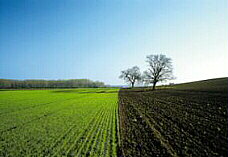 |
| MIntensive argriculture and inappropriate land use have provoked high concentrations of nitrogen and phosphorus, which are released to waterbodies |
Some of the environmental changes produced by farmers in the Danube River
Basin (DRB) have been positive, but many others have been negative. As is
well-known, agricultural developments since the 1950s have caused substantial
environmental damage in the region.
The main "driver” of agricultural change in the DRB during the
last 50 years has been an emphasis of farming policies in both the European
Union (EU) and the former communist countries on producing as much food
as possible. Although the policy measures adopted varied across the region
they shared the common objectives of encouraging both the specialisation
and restructuring of crop and animal enterprises, and the intensification
of crop and animal production through the increased use of agro-chemicals.
In addition to increasing food production, these policies have also led
to a huge increase in agricultural pollution – including point source
pollution arising from the accumulation of manure and slurry on intensive
animal farms, and diffuse pollution from the mineral fertilisers and crop
protection chemicals used in intensive crop production.
Agricultural pollution has declined during the last 10 years due to the
major changes in agricultural land use and farming methods that have taken
place during the post-communist period. However, this improvement may be
only temporary. It is possible, for example, that the on-going enlargement
of the EU into the DRB will initiate a new period of more intensive farming,
especially in the more fertile areas of the region.
Agricultural pollution and Danube Regional Project
Although the future direction of agriculture in the DRB is unclear, the
development of appropriate policy measures to encourage farmers to adopt
more sustainable, less polluting management practices remains a high priority
– and a major challenge!
One of the outputs of the UNDP/GEF Danube Regional Project (DRP) focuses
upon assisting the DRB countries in the design of new policies and practical
approaches for the control of diffuse and small point source pollution from
agriculture. Work has already begun on the work programme that will continue
through a series of stages to the development of an appropriate framework
of guiding principles, the so-called Best Agricultural Practice (BAP), for
promoting the integration of pollution control measures into everyday farm
management decisions and practical activities of farmers living and working
in the DRB. This supports the existing work of the ICPDR EMIS Expert Group.
The preparation of a series of BAP pilot project proposals for funding under
Phase 2 of the DRP will then follow-on later in the year.
Best agricultural practice for the DRB
BAP is not a new concept – codes of good agricultural practice for
the protection of water are a key element of the EU Nitrate Directive, whilst
the FAO Good Agricultural Practices Initiative aims to support the implementation
of concrete action towards the achievement of global sustainable agriculture
and rural development. Strict definitions of BAP should however be avoided.
It is particularly important that in DRB countries BAP is viewed as encompassing
a broad spectrum of activities that can be interpreted according to local
environmental, social and economic circumstances. Obviously not all aspects
of BAP will be relevant in all DRB countries. For example, it would be unrealistic
to expect a small-scale farmer in Moldova to understand how to undertake
the necessary calculations to limit manure application to 170 kg N/ha. Similarly,
collection of clean manure from house cows in the village is understandably
of no relevance to a large-scale commercial producer in the Czech Republic.
Ultimately, however, the widespread adoption of BAP by farmers in the 11
DRB countries supported by the DRP will depend upon governments developing
an optimum "mix” of policy instruments – to achieve this
it is necessary to first understand the current state of policy development
and implementation for agricultural pollution control, as well as the main
administrative, institutional and funding deficiencies that prevail.